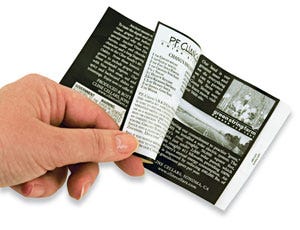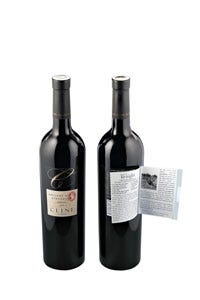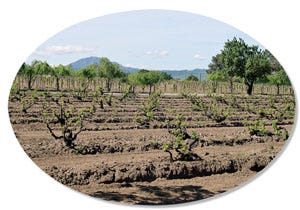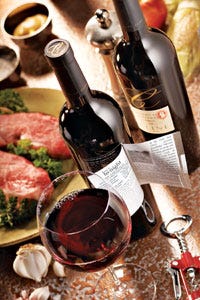Winery uses extended-text labels to tell its story
January 30, 2014
|
|
Sonoma, CA-based Cline Cellars is a progressive winery whose owners believe food and wine should go together. Nestled in the Contra Costa County area near Oakley, the winery was established in 1982 as owner Fred Cline preserved and restored many ancient vine sites to their rightful reign as premier California wine lands.
In 1991, the Cline family relocated the winery from Oakley to the Carneros region of Sonoma County on a historic 350-acre estate with new vineyards and facilities.
Steeped in history (once the site of a Miwok tribal village and the original last California Mission site before it was moved to Sonoma), much of the cool Carneros region is planted to Chardonnay, Pinot Noir and Merlot. At his winery, Fred Cline pioneered the planting of Rhône varietals including Syrah, Viognier, Marsanne and Roussanne.
Today, Cline's website devotes a whole section of recipes called “have it tonight” [for dinner], and suggests wine pairings with various entrees. “We wanted to provide value to our customers and thought that a recipe paired with the wine would help achieve that,” says Charene Beltramo, marketing and creative director at Cline Cellars.
|
“Green business is top of mind, and we wanted to let people know that we are doing our part,” Beltramo says. “In 2005, we installed solar panels to provide energy for the entire winery and improve air quality by reducing 690,000 pounds of noxious greenhouse gases per year. We also farm the Green String way, which is a natural and sustainable process utilizing organic and biodynamic farming practices.”
The winery had been placing tearaway promotional pads on store shelves near the bottles of wine. The tearaways were printed with mouth-watering recipes as a way of presenting foods that go well with its 2006 Ancient Vines Zinfandel as well a bit of Cline's own story.
But it was difficult to know if a recipe actually made it home with every purchase using the tearaway pads. And with so many wines competing for consumers' attention on store shelves, Cline's big challenge was getting consumers to notice the tearaway pad and to encourage them to take a sheet.
In late 2007, the winery adopted a new label format with help from WS Packaging Group (www.wspackaging.com) that allows it to convey a more detailed story to consumers. WS Packaging recommended that the winery try its EasyTab® extended-text label, part of its MultiVision® line of labels, for the wine bottles.
EasyTab is engineered to meet the regulatory requirements that allow consumers to open, read and reseal the label. The additional label space allows Cline Cellars a chance to share a recipe and tell the story about its 100-plus-year-old vines. The EasyTab label uses a patented “pre-curve” label construction in which WS curves the raw paper label stock to ensure that the consumer can open and close the multiple panels easily. Also designed for tight-diameter surfaces, the pre-curve construction avoids edge lifting and wrinkling when the label is machine-applied. It also features an easy-to-use peel tab that protects the overall label integrity.
WS produces the labels at its facility in Fullerton, CA. Each label incorporates five panels with each panel flexo-printed in two colors on 60# CS2 (coated-two-sides) offset paper label stock that's overlaminated with 2-mil PP adhered to a semi-gloss base label with a proprietary adhesive.
Equipped with an in-house bottling line, Cline Cellars uses an existing twin-station Cavagnino & Gatti (www.cavagninoegatti.com) rotary labeler from Italy to apply the labels to the back of each bottle. The roll-fed labeler helps keeps costs to a minimum. “The labels run fine on our regular line,” explains Beltramo. “No new equipment was required.”
The label unfolds to reveal the extra panels of additional instructions, the recipes and Cline Cellars' background and history and easily refolds and reseals for neat storage. Recipes include entrées such as duck breast with capers, olives and herb pan sauce. The label information mentions the particular grape used in the wine, and why it's significant as well as bottling information and mandatory copy. The panels can be rotated or can be printed with new copy in every production run, so the next time a consumer buys the same wine, they'll see a different recipe and have the opportunity to learn something new.
|
Connecting with consumers
Cline Cellars began marketing the wine with these new labels starting in October 2007 with its Ancient Vines Zinfandel. For the first vintage, it printed labels featuring four different recipes.
“When I saw the recipe tearpads, I asked whether or not it might be more effective to include a recipe on every bottle by switching the back label to an extended-text format,” explains Dan Hughes, senior account executive with WS Packaging Group. “The label had enough space to allow for additional information about the winery or wine.”
The original back label for the Ancient Vines Zinfandel bottle combined details about the wine with regulatory text. Being able to exponentially expand that label real estate offered the opportunity to fulfill the brand promise at a higher level. Shaping a brand involves cultivating the right perceptions, according to Cline Cellars.
The more detail shared about a product, and the more consistently it's delivered, the better the chance to get the message across, says Peggy Phelan, director of operations at Cline Cellars. “We think the new label format is an ideal way to combine a recipe for those interested in food with information about our vineyards for those interested in winery history. The more information we can give our customers about our brand–the history, the vineyards, the wine, the farming practices–the better.”
|
Phelan explains that the multi-panel label format was ideal for conveying to consumers in detail about its Ancient Vines Zinfandel. “We spent a lot of time thinking through the project with our production team,” she adds. “We did make changes to the design to ensure the label would work with our labeler. And we tested different adhesives. When the day came to bottle, we were confident there wouldn't be problems.”
Cline Cellars is pleased with the results of the extended-text project, Beltramo says. “We are one of the first wineries to introduce this type of label to the wine consumer. Fred Cline is a pioneer in many ways and this new label continues his efforts to grow and produce little-known varietals like Mourvedre, Carignane and Viognier.”
What wine goes with…?
The initial feedback about the labels on Cline Cellars' Ancient Vines Zinfandel has been so positive that in July 2008, the winery added an extended-text label to bottles of its 2007 Ancient Wines Carignane and in August 200, to its 2006 Ancient Vines Mourvedre varietal. The vintner included recipes and information about its farming practices, as well as details about its sustainability initiatives in solar equipment installation.
In fact, to expand the consumer experience even further, Cline Cellars presented its extended-text label recipe program to P.F. Chang's China Bistro restaurant chain and the chain liked the idea. An initial offering paired the Ancient Vines Zinfandel with P.F. Chang's recipe for a sauce that can be used for dipping, grilling or as a marinade for seafood, beef or chicken dishes.
“Consumer feedback has all been positive,” Beltramo says, adding that the winery is looking into additional restaurant and recipe pairings. “We're always evaluating and looking for new ways to share our message,” she tells PD. “WS has been tremendous to work with. They're always presenting good ideas to us. They're truly a business partner.”
More information is available: |
WS Packaging Group, Inc., 800/818-5481. www.wspackaging.com. |
Cavagnino & Gatti Macchine Etichettatrici, 39 0141 823231. www.cavagninoegatti.com. |
About the Author(s)
You May Also Like






